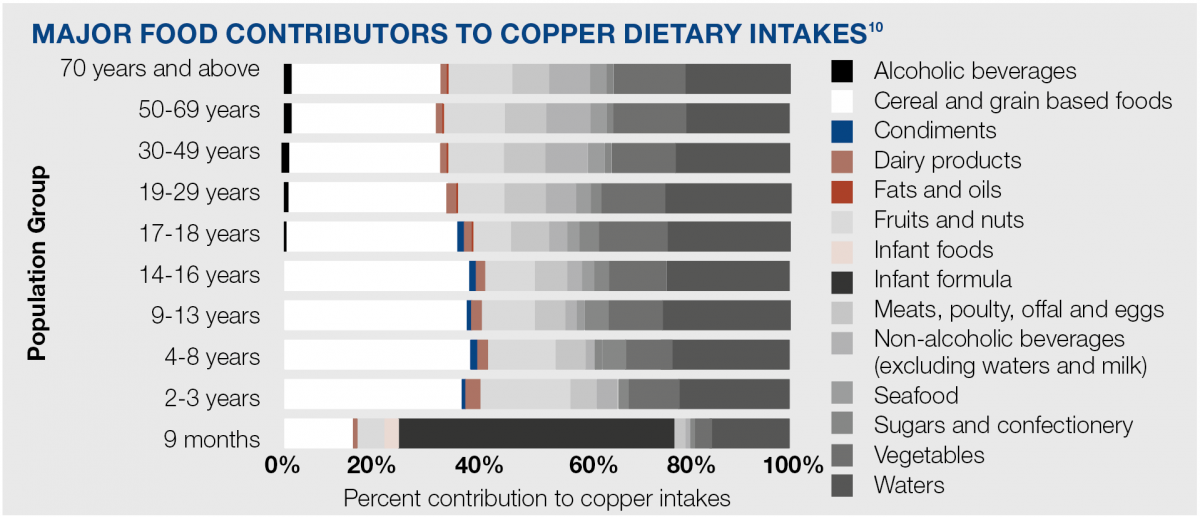Copper is a trace element involved in a wide range of biological processes vital to sustain life. Yet – as with many other metal ions – it is toxic when present in excessive quantities, especially for those with copper-sensitive disorders such as Wilson’s disease. Strict regulatory mechanisms control copper absorption and excretion through the digestive tract. Being an essential element, copper must be obtained through the diet. Current evidence suggests that copper deficiency may be more widespread than previously thought, while toxicity is uncommon under normal daily life conditions.[1]
Role of copper in body
Copper is a vital functional component of several enzymes that are involved in the regulation of various physiologic pathways, including energy production, iron metabolism, connective tissue maturation, immune function, neuropeptide synthesis and antioxidant defence.
The human body contains approximately 100mg of copper which is primarily stored in skeletal bones, muscle tissue and the liver.[2] Defects in copper homeostasis leads to disease. For example, Wilson’s disease, which results from genetic mutations, leads to the accumulation of copper in the liver and brain, causing liver malfunction and neurological defects including movement disorders, seizures, and depression.[3] Menkes disease, on the other hand, is caused by a different mutation that results in peripheral copper deficiency due to the failure of dietary copper mobilisation from intestinal cells to circulation. People with Menkes may present with symptoms such as seizures, profound neurological defects, abnormal thermoregulation, connective tissue disorders, immune cell dysfunction, as well as others. It also has the potential to lead to death in early childhood.[3]
Energy production
Copper serves as a cofactor for the enzyme cytochrome c oxidase, which plays a critical role in electron transport in the mitochondrial respiratory chain. Thus, it supports cellular energy production (ATP synthesis).[4]
Symptoms of reduced cytochrome c oxidase activity may include brain damage, hypothermia and muscle hypotonia as seen in patients with Menkes disease.[5]
Connective tissue formation and bone health
Another copper-containing enzyme, lysyl oxidase, is required for the cross-linking of collagen and elastin and is essential for the formation of strong connective tissue and bone.[4,6] Decreased lysyl oxidase activity in Menkes disease may manifest as arterial abnormalities, subdural haemorrhage, bladder diverticula, skin and joint laxity, hernias, osteoporosis and bone fractures.[5]
Iron metabolism
Iron metabolism is dependent on the copper-containing enzymes collectively known as multi-copper oxidases (MCO): ceruloplasmin, which represents majority of plasma copper; hephaestin and zyclopen, which are found in the intestine and placenta respectively.[4]
Disturbances with copper homeostasis leading to an imbalance in iron homeostasis are well documented.[7] The biosynthesis and activity of MCO are positively correlated with intracellular copper levels which are required for iron transport and loading of iron onto transferrin for red blood cell formation. Copper deficiency resulting in inhibition of MCO alters iron metabolism and restricts iron export from the gut and liver, leading to iron overload from this lack of transport, particularly in the liver, and resulting in anaemia in various other tissues of the body.[4,5,7,8]
Central nervous system
Numerous reactions essential to healthy function of the brain and nervous system are catalysed by copper-containing enzymes, including neurotransmitter synthesis and formation and maintenance of healthy myelin.[4]
Neurodegeneration seen in Menkes disease primarily results from a decrease in cytochrome c oxidase activity in neurons and attributed to subdural haemorrhage occurring secondary to abnormalities in brain arteries caused by reduced activity of lysyl oxidase.[5]
Immune defence
The link between copper and innate immune function has been recognised for decades.9 Even mild copper deficiency can lead to decreased number of circulating neutrophils (neutropenia) and impaired neutrophil function.[9]
Neutrophils isolated from copper-deficient subjects have been shown to have reduced phagocytic capacity and diminished bactericidal activity. However, these actions were restored upon dietary supplementation with copper.[9]
Antioxidant defence
Copper is an integral part of copper/zinc superoxide dismutase (SOD), a powerful antioxidant enzyme that catalyses the conversion of superoxide radicals to hydrogen peroxide, which can subsequently be reduced to water by other antioxidant enzymes.[4] Copper/zinc SOD is found within most cells of the body.
Dietary sources of copper
The copper content in foods varies according to local conditions, such as soil copper concentration, slurry/manure spreading, use of copper containing pesticides, and industrial copper emissions. The concentration in drinking water may also vary depending on groundwater composition and household plumbing systems.[2]
However, despite these variations, foods such as offal, seafood, nuts and grains, as well as water (non-bottled) are generally considered major copper contributors.
The 23rd Australian Total Diet Study (ATDS) demonstrated the greatest sources of copper intake in the Australian population based on age:10

Copper metabolism and regulation
Copper is absorbed primarily in the proximal part of the small intestine and transported to the liver via the portal vein. The absorption rate is close to 50% for copper intake ranging from 0.7-6.0mg per day.[2]
Based on a review of studies, intakes of <0.8mg per day lead to net copper losses, whereas net gains are observed above 2.4mg per day.2 Thus, the minimal amount of dietary copper required to achieve a null balance are thought to lie somewhere between 0.8-2.4mg per day.
Are we getting enough?
There is very limited data on copper status in Australia, however a recent study in female university students (n=308, aged 18-35) showed that 23% had copper levels below the recommended reference range.[11]
According to the 23rd ATDS, the estimated dietary copper intake among both males and females was highest in those aged 19-29 years (1.89 and 1.42mg per day respectively). Intake for both genders declined steadily beyond this age group.[10]
Toxicity
Copper toxicity is rare and, when it occurs, it is often associated with genetic defects of copper metabolism, such as in Wilson’s disease.
Copper toxicity as a result of dietary excess is generally not considered a health concern, probably due to the homeostatic mechanisms controlling its absorption and excretion.[2]
However, toxicity can follow from consuming contaminated food or beverages. Acute consumption of water/beverages containing high levels of copper (>30mg/kg) have resulted in gastrointestinal symptoms such as pain, cramps, nausea, vomiting and diarrhoea.[10]
Copper in Australian drinking water
Australia’s main water supplies are constantly monitored by the Department of Health to ensure copper levels do not exceed Australian Drinking Water Guidelines, which have set the acceptable values of copper at two levels. Based on health considerations, the concentration of copper in drinking water should not exceed 2mg/L, and based on aesthetic considerations, the concentration of copper in drinking water should not exceed 1mg/L.[13]
In major Australian reticulated supplies, total copper concentrations range up to 0.8mg/L, with typical concentrations of about 0.05mg/L.[13] However, some households experience elevated copper levels due to copper pipe corrosion. Copper is widely used in domestic plumbing (pipes and fitting) throughout Australia and where corrosion is an issue, the quality and safety of the drinking water may be affected, regardless of the levels in the actual water supply to the premises.
Fortunately, there are signs that can indicate a high level of copper is being consumed. For example, copper concentrations above 1mg/L may leave blue or green stains on taps and in the basin, shower or toilet over time, but this water is still considered safe to drink. A high level of copper usually leaves a metallic or bitter taste in the water and in these instances, may not be safe for consumption.[14]
If corrosion is an issue, there will be increased levels in the water supply where the water has been in stagnant contact (six hours or more, such as first thing in the morning) with copper pipes and should not be drunk or used in the preparation of food. In these instances, copper levels can be effectively reduced by flushing the taps for one minute.[13]
References
- de Romana DL, Olivares M, Uauy R, et al. Risks and benefits of copper in light of new insights of copper homeostasis. J Trace Elem Med Biol 2011;25(1):3-13. [Abstract]
- Bost M, Houdart S, Oberli M, et al. Dietary copper and human health: current evidence and unresolved issues. J Trace Elem Med Biol 2016;35:107-115.[Abstract]
- Festa RA, Thiele DJ. Copper: an essential metal in biology. Curr Biol 2011;21(21):R877-883.[Abstract]
- Higdon J. Copper. Micronutrient information center. Linus Pauling Institute, 2001.[Abstract]
- Kodama H, Fujisawa C, Bhadhprasit W. Inherited copper transport disorders: biochemical mechanisms, diagnosis, and treatment. Curr Drug Metab 2012;13(3):237-250.[Abstract]
- Medeiros DM. Copper, iron, and selenium dietary deficiencies negatively impact skeletal integrity: a review. Exp Biol Med (Maywood) 2016;241(12):1316-1322.[Abstract]
- Matak P, Zumerle S, Mastrogiannaki M, et al. Copper deficiency leads to anemia, duodenal hypoxia, upregulation of HIF-2α and altered expression of iron absorption genes in mice. PLoS ONE8(3):e59538.[Abstract]
- Vashchenko G, MacGillivray RTA. Multi-copper oxidases and human iron metabolism. Nutrients 2013;5(7):2289-2313.[Full Text]
- Djoko KY, Ong CLY, Walker MJ, et al. The role of copper and zinc toxicity in innate immune defense against bacterial pathogens. J Biol Chem 2015;290(31):18954-18961.[Abstract]
- 23rd Australian Total Diet Study (ATDS). Canberra: Food Standards Australia New Zealand, 2011. [Source]
- Fayet-Moore F, Petocz P, Samman S. Micronutrient status in female university students: iron, zinc, copper, selenium, vitamin B12 and folate. Nutrients 2014;6(11):5103-5116.[Full Text]
- National Health and Medical Research Council (NHMRC). Copper. Australian Government, and Ministry of Health. Nutrient Reference Values for Australia and New Zealand, including Recommended Dietary Intakes. Commonwealth of Australia, 2014. [Source]
- NHMRC, NRMMC. Australian Drinking Water Guidelines Paper 6 National Water Quality Management Strategy. Canberra: NHMRC and NRMMC, 2011. [Source]
- Copper in drinking water. Government of Western Australia, Department of Health, 2017. [Source]
DISCLAIMER:
The information provided on FX Medicine is for educational and informational purposes only. The information provided on this site is not, nor is it intended to be, a substitute for professional advice or care. Please seek the advice of a qualified health care professional in the event something you have read here raises questions or concerns regarding your health.



